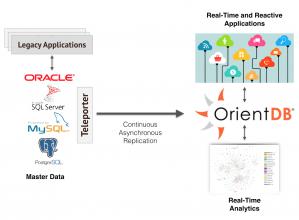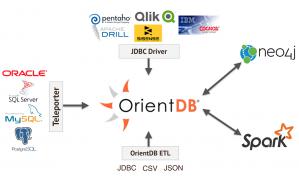OrientDB: The First NoSQL Database to Enable Synchronisation with Any Relational Database.
With the growing popularity of Multi-model databases, OrientDB expands integration capabilities and easily synchronise relational data to a NoSQL DB.
London, May 8, 2017
OrientDB Ltd, the company behind the world’s leading multi-model database, has become the first database vendor to enable relational database synchronization with its NoSQL database. Ranked as the second most popular graph database worldwide by popular database ranking site DB-Engines, OrientDB’s core incorporates graph and document features to address common polyglot persistence issues. With the continuing growth in popularity of multi-model databases, OrientDB continues to expand its integration capabilities while improving performance and scalability.
The advantages are many for entities using relational databases and hoping to address big data concerns. Most of these companies are integrating one or more NoSQL technologies next to a relational database. Unfortunately there is no standard between RDBMS and NoSQL and no automatic conversion tool that can perform this task. This makes transitioning data to NoSQL an expensive and difficult task, usually implemented through custom ETL.
In a market still dominated by relational databases, OrientDB created Teleporter, the first automatic tool to synchronize a database from the most popular RDBMSs to OrientDB. This allows both Relational and NoSQL technologies to coexist in companies, allowing a smooth transition to reactive and real-time applications and analytics.
“This is the problem we want to address,” commented Luca Garulli, Founder and CEO of OrientDB. “Companies are ready to use innovative technologies for data, but the legacy heritage is just too big to be migrated. OrientDB and Teleporter allow a smooth transition to the NoSQL world with a fraction of the cost and time investment necessary by using ETL or a SOA solution.”
Teleporter can easily import an entire database into OrientDB with just one click from OrientDB Studio Web Tool. Going further, for the more advanced use cases, it can keep the graph in OrientDB continuously synchronized with the RDBMS, allowing also complex transformations from tables in graphs with a high degree of configuration. Teleporter supports migrations from the most popular relational databases, including Oracle®, SQLServer®, MySQL®, PostgreSQL® and HyperSQL®*, and new RDBMS products will be added at the list soon.
“We understand that adopting newer technologies is no easy feat,” continues Luca Garulli. “Current production environments are usually comprised of multiple systems, with relational databases still taking care of financial data, document stores handling product catalogues and graph databases addressing recommendations. OrientDB makes transitioning to more efficient technologies easier. We know that most organizations dread making significant changes to their production environments, even if that means sticking with outdated technologies. Uncertainty with results and fear of instability causes most entities to stick to their current infrastructure, which can eventually lead to increased infrastructural and personnel costs as teams grow to handle multiple paradigms with data. With OrientDB 2.2, we addressed these issues, allowing these transitions to be performed gradually and seamlessly.”
Aside from their relational data approach, OrientDB boasts a comprehensive bundle of integration tools. For those hoping to add multi-model capabilities to their graph data, OrientDB’s latest Importer tool, which enables Neo4j® Graphs to be imported into OrientDB with ease. The connector allows Spark’s capabilities to be leveraged using OrientDB as the datastore. While many ETL tools support OrientDB natively, they also provide their own ETL tool. By combining these features with the built-in JDBC driver and a comprehensive security suite, this means third-party access to OrientDB databases can be performed securely and efficiently. OrientDB 2.2.19 is currently the latest stable release, though the first Milestone of 3.0 has been recently released for testing. Building on their current success in attracting users from relational and graph databases alike, their upcoming version places strong focus on Teleporter as well as Importer enhancements. “We’re glad to see a shift towards multi-model databases in recent years. However we knew that one of the challenges in introducing innovative technologies, advantageous as they might be, was providing an efficient method of transition,” says Garulli.
OrientDB combines the connectedness of graphs, the agility of documents and a familiar SQL dialect. It incorporates a search engine, Key-Value and Object-Oriented concepts along with a reactive model and geospatial awareness. Fortune 500 companies, government entities and startups all use multi-model technology to build large-scale innovative applications. Some of OrientDB’s clients include Accenture, Comcast, Ericsson, the United Nations, Verisign, Pitney Bowes, Sky, Diaku, CenturyLink and Sonatype.
*All trademarks are property of their respective owners.
Paolo Puccini
OrientDB
+44 020 3397 1350
email us here
Legal Disclaimer:
EIN Presswire provides this news content "as is" without warranty of any kind. We do not accept any responsibility or liability for the accuracy, content, images, videos, licenses, completeness, legality, or reliability of the information contained in this article. If you have any complaints or copyright issues related to this article, kindly contact the author above.



